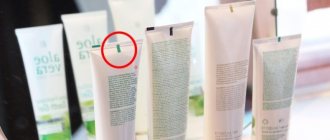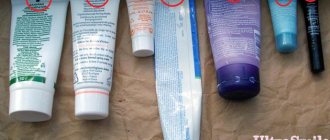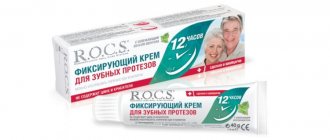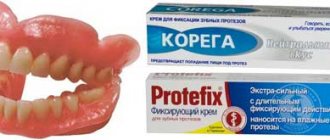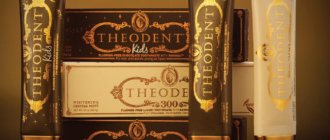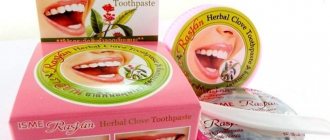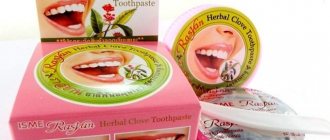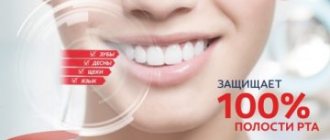There are so many different myths about what the colored stripes on toothpaste tubes mean. Allegedly, they are talking about harmful substances, the permitted frequency of using the paste, and what country or city it was actually made in. The most advanced manufacturers began to produce toothpastes in tubes with a green stripe, supporting the myth of their naturalness. But in fact, such assumptions are wrong, and any dentist can confirm this.
Basic myths about color marks on tubes
According to some consumers, the colors of the stripes on tubes of toothpastes, ointments and creams indicate the characteristics of their composition:
- Red is about synthetic.
- Green is about the environment.
- Blue and brown indicate that the product is half natural.
- Black - contains only chemical components.
Another part of consumers is of the opinion that colored markers indicate the degree of abrasiveness, the presence of protective properties, or the cost of hygiene products.
| Color of the strip on the paste tube | Number of abrasive particles | Protective properties | Price |
| Red | Few | Although it contains synthetic components, it provides the required degree of enamel protection. | Expensive product |
| Green | No | Effectively protects teeth and oral cavity from diseases thanks to its ecological composition | average cost |
| Blue, black, brown | A lot of | Has a low degree of protection, provokes periodontal disease | Cheap remedy |
Which toothpaste is the most natural?
We have selected reviews of the 10 most popular natural toothpastes.
- Toothpaste
Black… - tooth
powder “Calendula”…
OrganicMiracle Fluoride Free Whitening Toothpaste- Gel toothpaste
with vitamin B12 without fluoride... - Toothpaste
Fresh breath... - Complex natural toothpaste
Propoline.
GOST and multi-colored stripes
A modern tube of toothpaste made in Russia must comply with three GOST standards at once:
- GOST 7983-99 (based on ISO 11609-95) talks about the correct marking of a paste mass and what it means.
- GOST 14192 and 28303 indicate the requirements for containers.
These documents state that:
- It must be indicated on the tube:
- Product name;
- brand;
- trademark;
- volume;
- compound;
- acceptable storage conditions;
- best before date;
- availability of relevant certificates.
- The marking is applied in the language of the manufacturer and the importing country.
- Permissible deviations from weight are 5%.
- Containing materials must be environmentally friendly.
But none of the GOSTs talks about the meaning of colored stripes on toothpaste and the rules for applying them. That is, the state does not regulate in any way the procedure for applying a “color barcode” ; the company itself decides the issue of marking toothpaste with colored stripes and can do without these designations.
CC cream
This product combines the properties of foundation and care cream. The name comes from color control. Although CC cream has fewer foundation pigments than BB cream, it contains more care ingredients. For example, vitamins, minerals, hyaluronic acid.
CC cream evens out tone, adapting to the natural shade of the skin, but does not mask serious imperfections. CC cream is a good option for the summer. If you have normal skin without flaws, then it is not a fact that the difference between BB and CC cream will be noticeable.
Why are multi-colored stripes applied?
In fact, the colored stripes on the tubes are an identification mark for the conveyor during automated production. They are necessary for high-quality separation of the tube blank from the conveyor belt.
Stripes on pastes
The technological sensor detects the color marking and cuts off the future tube of toothpaste. After this, the plastic sheet is twisted, glued and filled with gel content. After these manipulations, the tube is finally glued and closed with a cap.
The color of the mark on toothpaste, by and large, means nothing. The manufacturer can independently choose the range and height of the strips, regardless of the chemical composition of the product and the shape of the container.
Streaks on creams
Creams are marked as the products move along the conveyor belt in a non-contact manner using special color markers read by conveyor sensors. They allow you not only to correctly cut and solder the tube, but also indicate places for applying drawings and text on the container.
Information about the composition and manufacturer is applied by inkjet using special ink. That is, red, black and other stripes are needed only in the process of producing creams using robotic technology.
Alternative theory
mythological meaning is sometimes attributed to flowers on toothpaste :
- Black: composition for whitening tooth enamel. Recommended for use no more than once a week;
- Blue: the mass is suitable for everyday use;
- Red: there is a healing effect. Such products are sold in pharmacies and prescribed by dentists in case of painful teeth;
- Green: designed to consolidate the healing results achieved by the previous composition. Recommended for use within 4 weeks after the treatment course.
Other decryption options are also possible. The gradation of colors is often interpreted as a distribution by price categories of goods, where the green marker is an indicator of an elite and expensive “eco-product”.
The True Meaning of Flowers
Despite the simple explanation for the appearance of stripes on toothpaste tubes, a certain color is chosen for a reason. The choice of mark shade is influenced by:
- Tube color. A black (dark) stripe on the toothpaste means that the main tone of the blank and tube is white or just a light shade. Light marks are typical for dark-colored containers, but manufacturers who decide to choose this shade of marker take a risk, since the photo sensor may not “catch” it during the soldering process.
- Limited choice. Typically, the marking involves 4 basic shades (CMYK - Cyan Magenta Yellow Black). Additionally, a fifth color can be used to print a barcode, text, or one light mark.
That is, the correct reading of the marking by the optical sensor depends on the contrast of the stripe and the main color of the tube. Most often, the tags are darker than the background, which allows the sensors to read the necessary information most efficiently.
When choosing a marker shade, packaging design is no less important. This means that if there are blue elements on a tube of toothpaste, then the stripe on it will be blue. Since the stripes on tubes of creams and pastes do not mean anything important (impact on the enamel), they can easily be replaced by other design elements at the discretion of the manufacturer.
Technological photo marks can be divided into 2 types based on their position on the sheet:
- horizontal markers are placed for precise cutting of the main workpiece when printing on a rolled laminate;
- vertical marks are needed to accurately indicate the location of the cut when soldering the tube, so that it is parallel to the main text and image on the final product.
Quality assessment criteria
A high-quality toothpaste should not contain the following substances:
- Sodium dodecyl sulfate - used to form foam. It is inexpensive, so it can be found in products in the low price segment. It has a negative effect on the skin of the oral cavity, is one of the causes of early baldness, and can reduce visual acuity. It tends to accumulate in the body, so daily use of such substances is not recommended;
- Triclosan is designed to destroy and inhibit the growth of pathogenic bacteria. Along the way, it destroys a number of microorganisms necessary for health;
- Fluoride helps in the prevention of caries and other dental ailments, but is quite poisonous. If large quantities of fluoride or fluorides are accidentally ingested, poisoning may occur;
- The controlled abrasiveness index should be within 100 for healthy teeth.
On the Internet you can find a wide variety of explanations of what the stripes on toothpaste tubes mean. Allegedly, they indicate the degree of environmental friendliness or the price category of the product. But in fact, their purpose is exclusively practical and makes sense only for a machine on a conveyor belt .
Video: codes on tubes
In this video, Igor Mulatov will tell you how manufacturers label toothpaste tubes and what the green and blue squares on the packaging mean:
Labeling procedure
Color division depends on the equipment and the number of coloring sections. At the preparatory stage, one main color is taken, which will contrast most with the color of the tube. Based on it, the features of reading elements and printing a barcode are determined.
If you use two colors at once, for example, blue and black, this will lead to unreadable text when the equipment is moved. Optical sensors correctly capture one primary color (red, green). Most often, white color is used for the background, since all the colored stripes are clearly visible on white tubes; the height and width of the marks are discussed individually. This approach allows us to minimize the costs of producing and placing information on tubes using a printed, non-contact method.
But the color of the marking has nothing to do with the composition of the gel. Typically, the tubes are manufactured by a company that has nothing to do with the development of the personal care product itself and dentistry, so its labels simply by definition cannot refer to the chemical composition of the paste-like mass. If stripes on toothpaste mean anything, it clearly doesn't matter to the end consumer.
Depending on the required parameters of the tube, a large blank sheet is divided into parts of a certain size. Light marks are placed as delimiters. They indicate the location of the incision to produce a tube of the required volume. Different colors of markers help identify manufacturing defects and other technological defects.
The stripes on toothpaste do not mean anything, so you don’t need to look closely at them and look for a secret sign in them. If you need to choose a paste with some specific indicators, you should look for information about them not in strips. The content of synthetic and natural substances in the gel can be found by reading the composition information posted on the tube.
Features of container production
Before answering the question regarding the true meaning of squares on containers, you need to provide information about the features of their production.
Creating regular tubes looks like this:
- The polymer blank is cut into pieces of a certain length and width;
- The logo, barcode, manufacturer data and other information are applied to the tube;
- Rolling up a segment that takes the shape of a cylinder;
- Sealing the edges of the sample (on one side);
- Filling the container with cream (or other substance);
- Clogging and sealing of the cylinder;
- The date of manufacture and expiration date are printed on the seam. light mark” is also affixed , thanks to which the machine recognizes the exact location where the cut needs to be made.
The specified sequence of actions is applicable to the process of manufacturing plastic products. The mechanism for creating aluminum tubes is somewhat different, but the placement of a color marker also takes place.
